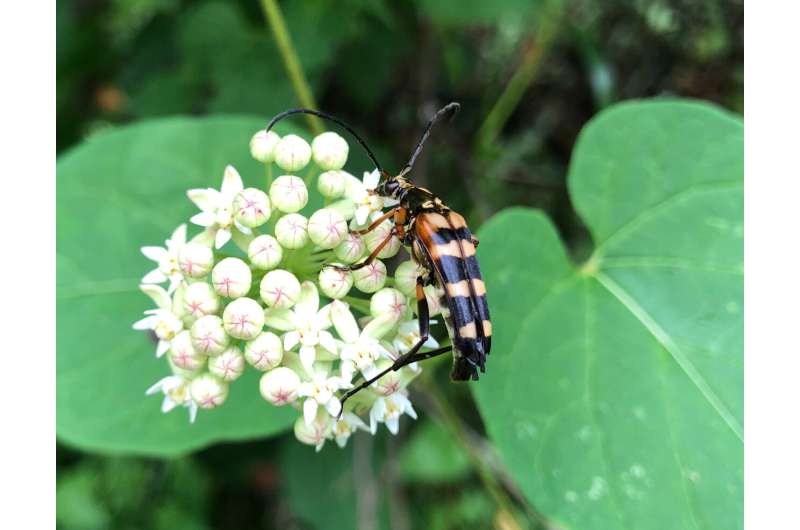This article has been reviewed according to Science X's editorial process and policies. Editors have highlighted the following attributes while ensuring the content's credibility:
fact-checked
peer-reviewed publication
trusted source
proofread
Symbiotic yeast helps longicorn beetles eat wood

Even for insects, wood is a tough food source as it contains hard substances such as cellulose. To help make wood more palatable, some wood-feeding insects are assisted by symbiotic microorganisms that break down the components of wood into an edible form.
A group from Nagoya University in Japan has isolated a symbiotic yeast from adults, larvae and eggs of the Japanese longicorn beetle and identified specialized organs that store the yeast, allowing the beetles to break down the unpalatable components of wood. Their findings were published in PLOS ONE.
"I have been fascinated with longicorn beetles since childhood because there are more than 900 species in Japan and they just look cool," said Dr. Wataru Toki, a lecturer at Nagoya University. "When I visited forests as a boy, I wanted to see new longicorn beetles that I had never seen before. As a researcher, I am interested in how they eat wood, because after all humans cannot eat wood. I found several studies that suggested microorganisms could be the key."
Wood is an important part of the life cycle of the longicorn beetle. After visiting flowers to collect pollen, the female Japanese flower longicorn beetle lays eggs on dead and rotting wood. Within a month, the larvae hatch and burrow into the wood. They feed and pupate before hatching into adults. Understanding how the larvae survive by eating wood is important because they help decompose dead wood, contributing to the cycling of nutrients in the forest.
A research group led by Ms. Mako Kishigami, a former master's student; Mr. Fumiaki Matsuoka, a current master's student; and Dr. Wataru Toki, a lecturer at the Graduate School of Bioagricultural Sciences, Nagoya University, in collaboration with the National Institute of Genetics and the Forestry and Forest Products Research Institute, studied longicorn beetles in their larval and adult stages. They discovered that the beetles have special organs that allow them to use a symbiotic yeast called Scheffersomyces insectosa. They also found that the yeast breaks down components of the wood, turning it into a food source.
The yeast was isolated from the membranous tubular pouch in the egg-laying tube of adult females and larvae, particularly in an area near the gut that contains cyst-like tissues, called mycetomes. When the yeast was tested in culture experiments to see if it could break down wood components, the researchers found that it broke down xylose and other wood components that the insects could not break down on their own.
"These results suggest that yeast is passed from mother to offspring through egg-laying, and that it plays an important role in the growth of wood-eating offspring," said Toki. "The mother places the yeast onto the surface of the egg during oviposition (the process of laying eggs). The hatching larvae then acquire the yeast by feeding on the eggshell. The offspring grow up storing the yeast in their mycetome, and when they become adults, they take the yeast into their mycetangia (a special organ for storing the yeast) and transport it to the next spawning site."
"Wood-feeding insects are abundant in forests, but only a handful of them are known to be associated with any specific microorganism. This study is the first to identify a symbiotic relationship with yeast for the Japanese flower longicorn beetle, the most familiar insect in Japanese forests," said Toki. "Other uses of the yeast are also possible. If the yeast produces antibiotics, this may protect the beetle from pathogenic microbes."
More information: Mako Kishigami et al, Yeast associated with flower longicorn beetle Leptura ochraceofasciata (Cerambycidae: Lepturinae), with implication for its function in symbiosis, PLOS ONE (2023). DOI: 10.1371/journal.pone.0282351
Journal information: PLoS ONE
Provided by Nagoya University



















